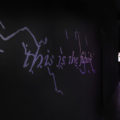Fragments of the Present: Katharina Grosse, “It Wasn’t Us”
For the original German version of this text please visit pokusberlin.com
Between presence and past future
An iceberg, consisting of several fragmented floes, rises from the one-dimensional, colourful surface on the ground. What remains is a polygonal hole, the edges melt away, seemingly flowing into the abyss. Streaks pull out of the surface, just a small tip protrudes above the hole. A part of it has come loose, explosively pushing itself towards the exit of the building. We visitors can witness this short, fleeting moment and, as if trapped in a time capsule, marvel at the eruption of colour from the surface.
Or did the object not explode, but leak? It drags streaks behind it like a snail drags its slime trail. The overlapping, partly blurred colour areas remain rainbow-like.
A woman with a red mask, red bag and red smartphone case merges with the colored sculpture, spots of colour like the green, blue, red, yellow, violet on the monstrous, sharp-edged block. A stumble. Rustling of trousers, almost sacral murmuring from the background. We are witnesses of an outbreak, a monumental moment.
Katharina Grosse’s multicoloured polystyrene sculpture captivates photographers and is suitable as a photographic backdrop. We see a colourful spectacle, a landslide and volcanic eruption all in one. We as visitors are part of this moment, visiting and documenting the find, the colourful artificial natural phenomenon. The multidimensional sculpture reveals furrows and caves at its core. Hiding places, secrets. From all sides one can, if one is allowed to approach the object, examine it.
To the right I see a small fragment of the iceberg that has been pushed in the opposite direction. It sits right at the entrance, but people walk past it. The spectacle awaits elsewhere. There seems to be a competition on who can reveal the installation’s secret by taking the best photo. Instead of observing the object closely, visitors pull out cameras in order to track the pictorial object. A double change of perspective, possibly stemming from the time of confinement.
Today is the first day since the lockdown that the Hamburger Bahnhof opens its gates to the public. The three months spent mainly in digital spheres seem to have amplified the desire to view analog experiences through a digital lens to show results, to announce I was there. Do we need the translation into digital to understand an experience? Or do we postpone the discussion until later? What does it say about our relationship to art that we put perception in a waiting loop to which we may never return?
Katharina Grosse’s sculpture is just such a snapshot, the absolute present before the object moves on. Or breaks away. Because doesn’t it rather break through the colourful surface on the ground? And thus does not escape, but is attracted and only tries to stop this ephemeral moment of disappearance?
The absolute present.
I leave the hall and stand outside. Here, too, I see the coloured streaks on the asphalt. To my right two observers are leaning on their bicycles just behind a barrier. The Rieckhallen, which are home to the Flick Collection, have also been painted. A vision of the future with colourful streets and facades. A mother to her child: Imagine all the streets were like this. Indeed, what if?
In times when exhibition spaces are even more inaccessible, due to time-slot tickets and reduced numbers of visitors, Katharina Grosse brings the museum into the public, urban space. In this way, she allows non-visitors of the exhibition inside the Hamburger Bahnhof to experience her shared colour vision in front of the building. Even outsides it radiates in all spectral colours.
In the rather sterile Europacity, the picturesque areas bring in a personal touch. Ductus and gesture in a uniform planned city. Only separated by the Flick container, which will also disappear soon. Cycling, football and basketball in front of, inside and on art. Painting expands into the everyday life. But what will remain of Katharina Grosse’s installation after being dismantled in January 2021? The sprayed foils will be removed from the floor, the multidimensional Styrofoam sculpture is going to be recycled, and the now colourful Rieckhallen will disappear. A utopian body, a thought construct, will live on.
Katharina Grosse’s snapshot falls into place with these current times. We are at a point where change can and must take place. After the Corona Crisis we cannot continue as before. It wasn’t us – but we should make sure collectively that it doesn’t stay that way.
I walk through a meadow, heading towards benches. Now am I outside the installation, or right in the centre?
Berlin, June 14, 2020
Katharina Grosse, It Wasn’t Us, 2020
Hamburger Bahnhof — Museum für Gegenwart Berlin
14.06.2020 — 10.01.2021
curated by Udo Kittelmann and Gabriele Knapstein
Image: It Wasn’t Us. Exhibition view Hamburger Bahnhof – Museum für Gegenwart – Berlin, 2020 / Courtesy KÖNIG GALERIE, Berlin, London, Tokyo / Gagosian / Galerie nächst St. Stephan Rosemarie Schwarzwälder, Wien © Katharina Grosse / VG Bild-Kunst, Bonn 2020 / Photo: Jens Ziehe






